Content Marketing Operations: Evolution and Automation
More than two decades ago, while introducing the World Wide Web, Bill Gates had said, “Content is the king”. He talked about the onset of digital marketing and explained how anyone with a computer and internet could produce content. This meant plenty of new revenue opportunities for content providers.
In modern times, we can say that content without context does not generate any value. So, the saying could be “Content is the King, Context is the queen”. In this blog we are going to see how content has evolved to become the focus of most digital marketers.
Why is content so important?
Content, especially digital content, refers to all kinds of textual, graphic, video, or interactive elements we see online. It could be digital assets like blogs, brochures, articles etc. that are shared, or even web content like the pages on a web site.
Marketing teams across the globe use content in various forms, across various channels, to share information, engage and attract new and existing customers. According to HubSpot, 81% of companies see content creation as an essential part of their business strategy1. Marketers even use user-generated content (UGC) to draw insights, convert customers, and influence customer decisions.
In 2011, Google introduced the world to the concept of “Zero Moment of Truth”6 – the exact moment a customer consumes the information before purchasing the product. However, with time and research it was observed that ZMOT is not a single discrete moment, but a sequence of touchpoints. This has made content and creating content even more important. Marketing has matured as a pull mechanism and enterprises are creating their own channels to remove the dependency to publish content.
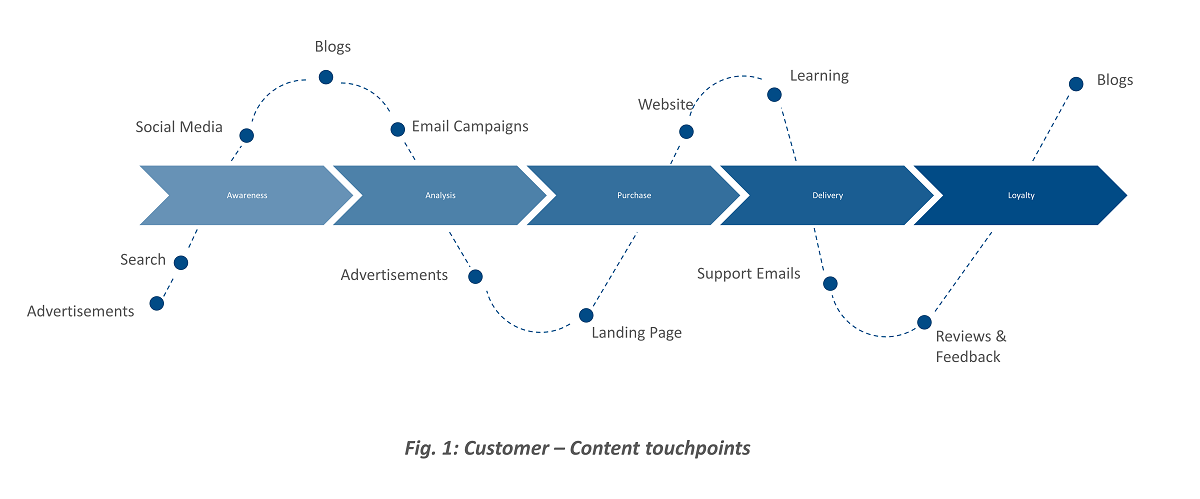
To understand content marketing operations, we need to look at how content creation has evolved through time.
The inception of Content Marketing
Marketing operations can be dated back to the early 1900s. Marketers started using radio as a medium to find and reach out to potential customers. In the 1930s, Proctor & Gamble pioneered content marketing with daytime drama sponsorship on radio. They advertised Oxydol laundry detergent and Ivory Soap to women listeners, during serial dramas (also led to coining of the term soap operas). This was an early instance of using original content for marketing goals.
An early instance of using content to create brand awareness, Michelin started publishing yearly guides for automobile maintenance. When they realized, the guides weren’t getting sold, they added restaurant reviews to boost the sales.8
The late 1950s saw emergence of multi-channel content marketing, with Exxon’s “Put a tiger in your tank” ad campaign. They created content and published the same message across multiple channels (TV, print etc.).10
It wasn’t until 1996 that the term “Content Marketing” was coined by John Oppendahl and digital content gained visibility amidst the dot com bubble. In the 2000s, social media was born when Orkut and Facebook were created, and content sharing became possible with the launch of the iPhone. This revolutionized the digital marketing landscape, making content the focus.
Content marketing in the present day
Since then, multi-channel marketing, social media and SEO have converged into a new form of content marketing. Content marketing now aims at leveraging technology to optimize content creation and usage. It aims to boost efficiency by streamlining the processes and effectively use various channels to engage with the right set of customers.
P&G, one of the earliest proponents of content marketing, has moved away from traditional content and streamlined their content operations. They used a Content Management System to launch 231 new digital properties in 20167.
Marketers of Citizen Watch spent a lot of time responding to retailers with relevant assets instead of concentrating on creating the digital assets. Since 2013, they started using a digital asset management tool that lets the retailers access the required promotional content1. It was also the content repository for the ecommerce website.
Over the past decade, organizations have shifted their focus from creating content to creating strategic content. Content marketing operations has become the driver for customer experience. As customers are constantly connected to the internet and social media, they consume information all through the day. They expect businesses to not just meet their demands, but also to predict their needs. Consequently, content has had to evolve to ensure it was targeted at the right set of people at the right time. A prime example of this is Netflix, where every user profile is customized based on the watch history. From the homepage icons to the show suggestions, they have been able to successfully engage with 80% of the users, merely through recommendations9.
Content Operations
Now that we know what content is, how it has evolved, and how it impacts business goals, let’s delve into how it is created.
Enterprises have been seeing marketing move from traditional channels to custom ones. The resources they spent over the last 30-40 years for creating traditional marketing capabilities are becoming obsolete. Content management processes are becoming more complex and demanding. This has motivated them to revamp the way content is created and published. As a result, content operations emerged. The process of planning, creating, modifying, storing, publishing, distributing, and deleting or archiving content to reach those business goals can be termed as content operations.
Content operation consists of three facets-
Processes –
Every organization aims to create content more efficiently. Starting from the planning to archiving, each type of content is treated differently. So, teams need to map out content workflows and redesign the process to ensure increased efficiency. This would begin with analyzing content strategy, standards to be maintained, channels, permissions, approvals etc. Even the analytics to be captured should be considered when making the decisions.
People –
To manage the content operations, it is essential to have the right set of people working on the content. There are many responsibilities like creating the content strategy, maintaining the standards, manage the publishing and the scheduling, crafting the content as well as taking care of the analytics. Each stakeholder is usually tasked with a different responsibility to ensure smooth operations.
Platforms –
Different tools and technologies can be leveraged to ensure productive content operations. For every step of the workflow, we can find tools that fit the purpose and improve efficiency of the people.
In a nutshell, content operations is the conjuncture of the people working on the content, the technology used to create and maintain the content and the processes in place to facilitate them.
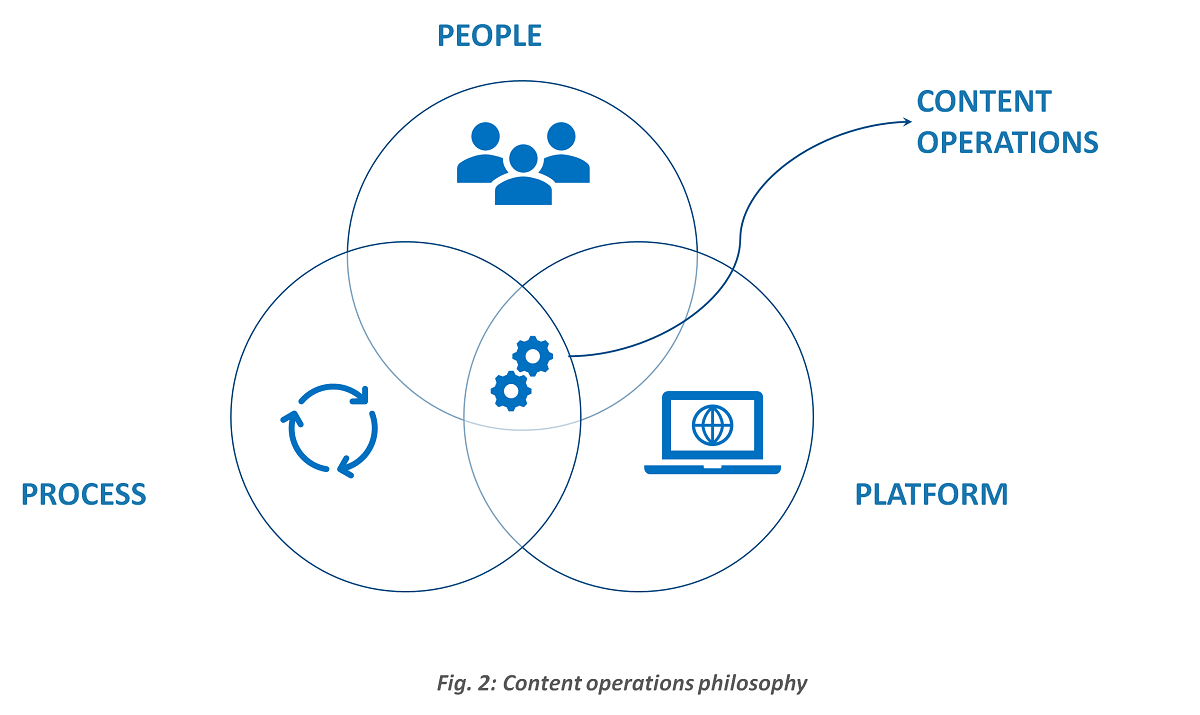
Networked Content Marketing Operations: Integrations and Automations
With the huge amount of content being created, it becomes imperative that enterprises optimize the time taken to manage them. Technology thus becomes the marketers’ best friend. Marketing technology, also known as Martech, has also seen evolution like content marketing and content operations.
In 2011, there were around 150 players in the Martech space. Customer Experience, External Promotion, and Marketing Management could be considered as the major categories of tools present in the market3. Fast forward to 2022, there are now nearly 10000 players in the market. There has been a 24% jump in the number of tools just between 2020 and 20224. Now the stack can be classified to Advertising & Promotion, Content & Experience, Social & Relationship, Commerce & Sales, Data, and Management.
Since our focus is Content & Experience, let’s see some of the tools in this category –
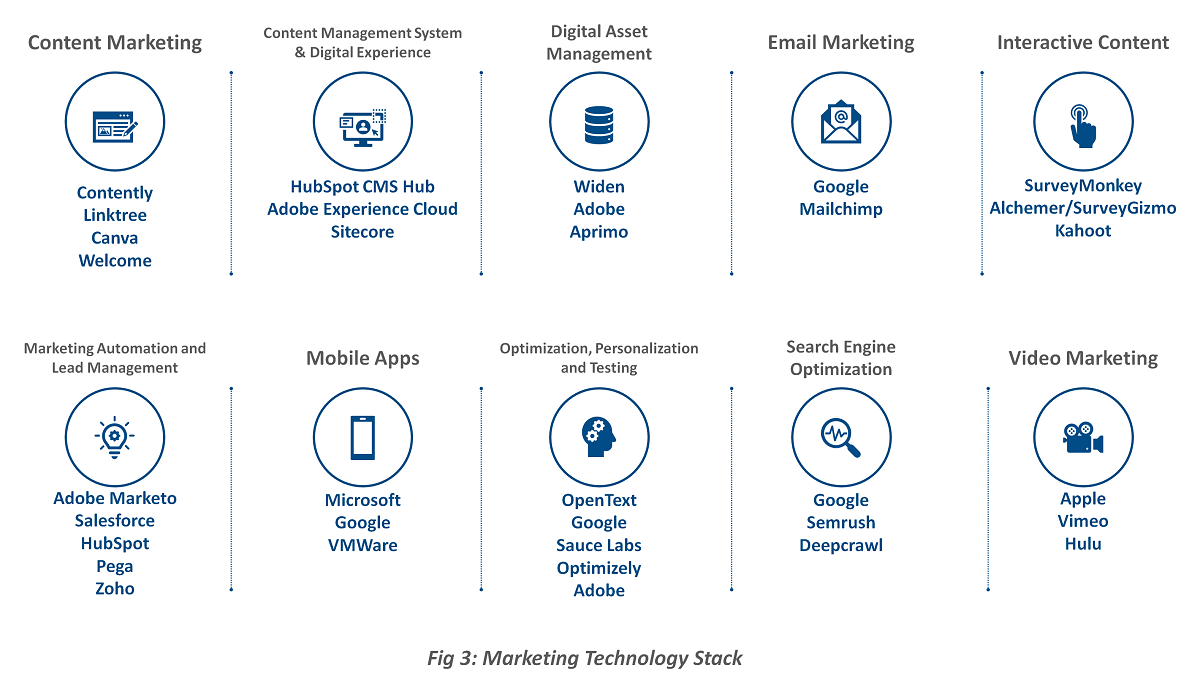
Looking at the vast MarTech landscape, it is essential to choose the right combination of tools that caters to the enterprises’ needs of managing content. Depending on the scale and intricacy of operations, organizations might choose Sitecore or Adobe Experience Manager or other tools. Using integrations, it is possible to create a network to optimize the content operations with middleware solutions like Microsoft Logic Apps, Dell Boomi, Workato etc.
To automate content operations, the stakeholders must understand the current processes and platforms to identify the pain points and convert them to opportunity points and bridge the gaps.
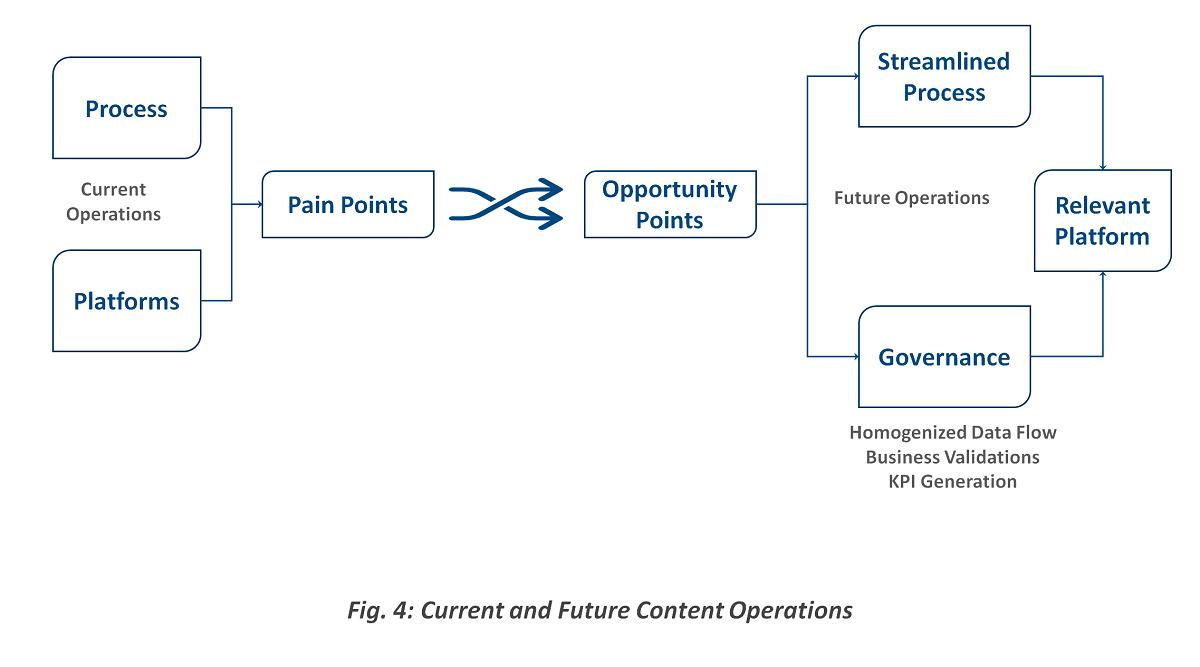
They can select the platforms to be kept in the network, the redundant ones to be excluded as well as the information shared across them. The metadata flowing across systems will ensure governance. The middleware can manage the enforced validations and homogenize the data. Considering every business function differently, business rules become critical for creating relevant content. But less number of touchpoints help the marketers to increase efficiency.
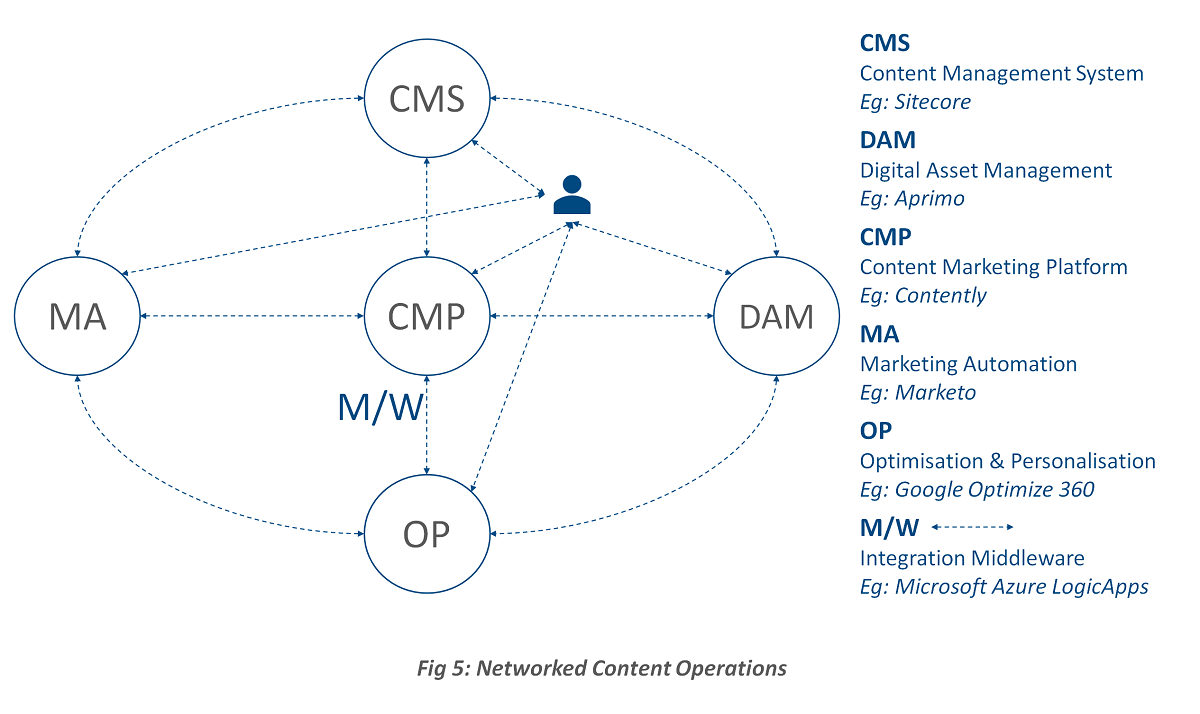
Having a networked content operation also brings out the efficiency of the content.

Let us look at an example:
When KPIs are captured once the content is published, marketers can see the response from customers. They can evaluate the effort and time spent in creating the said content as well as the number of engagements to realize its worth. In contrast, content created with lesser effort might be engaging an equal number of customers. It will also highlight the bottlenecks as well as points of improvement in the process of content production.
Looking at the network in the diagram, it is clear that to streamline the content operations, technology should be leveraged only where necessary. Automation does not replace the human connection; it simply aids it.

Content operations best practices: Create stronger content at scale 2022
LTIMindtree Offerings – Improving business goals
LTIMindtree has enabled the marketing community of the world’s largest medical diagnostics company – across the globe – to create an ecosystem that integrates its MarTech stack with an orchestrator to drive content creation. The client was looking to connect the CMS (Sitecore), the Digital Asset Management Tool (Widen) and its regulatory approval system (Veeva Promomats) with the CMP (Welcome) using Azure LogicApps and FunctionApps as the middleware solution. This solution enabled marketers to create digital assets and web content from a single point in a metadata driven approach. Over 800 marketers across the world were able to collaborate and are currently benefiting from the efficient content operations. Campaign Management System (Marketo) to create marketing campaign was integrated as the second phase as well. More than 13 workflows have been automated since and have increased productivity multifold.
It is also possible to integrate other tools from Sales enablement and Ecommerce business units by including these tools in the mix. If sales teams curate customer recommendations or ecommerce team list products with pertinent content more effectively, they have capacity to focus on their core strengths. Content will not only drive marketing but also impact revenue operations. With the MarTech stack evolving, marketers can stay ahead just by letting the automation increase efficacy and reduce the time to market of the content.
https://blog.hubspot.com/marketing/content-creation
https://www.widen.com/resource-library/case-studies/citizen-watch
https://chiefmartec.com/2011/08/marketing-technology-landscape-infographic/
https://chiefmartec.com/2022/05/marketing-technology-landscape-2022-search-9932-solutions-on-martechmap-com/
https://www.cincinnati.com/story/news/2017/10/04/our-history-p-g-put-soap-soap-opera/732149001/
https://www.thinkwithgoogle.com/marketing-strategies/search/zmot-why-it-matters-now-more-than-ever/
https://www.sitecore.com/customers/consumer-goods/procter-gamble
https://www.stratwell.ca/michelin-guide-content-marketing/
https://www.entrepreneur.com/growing-a-business/lessons-in-personalization-what-netflix-can-teach/423024
https://www.buzzvalve.com/post/the-remarkable-evolution-of-content-marketing
Latest Blogs
Core banking platforms like Temenos Transact, FIS® Systematics, Fiserv DNA, Thought Machine,…
We are at a turning point for healthcare. The complexity of healthcare systems, strict regulations,…
Clinical trials evaluate the efficacy and safety of a new drug before it comes into the market.…
Introduction In the upstream oil and gas industry, drilling each well is a high-cost, high-risk…




